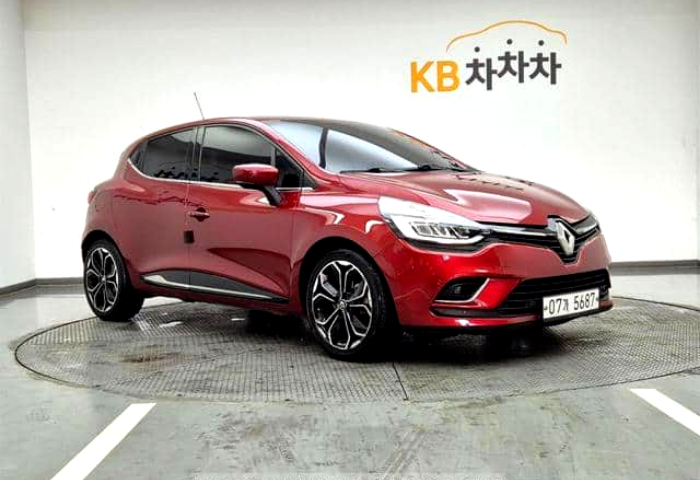Your cart is currently empty!

10 Common Renault Clio Problems (And How You Can Fix Them)
After meticulous research, I have uncovered the common Renault Clio problems. Are you having issues with your car, or do you want to know what to expect/ You’re in the right place. This guide covers ten issues. For each of these Renault Clio problems, I will explain their causes and share practical tips on how to fix or prevent them. It doesn’t matter if you own a gas-powered or hybrid model. I’m covering everything. But before we get into it, let me share with you a little backstory on the Renault Clio.
The Clio has been a familiar sight on roads since 1990. It earned its place as one of Europe’s most popular superminis, alongside cars like the Honda Jazz and the Mazda Demio. It is mostly known for its stylish looks, but it’s also comfortable and fuel-efficient. In the UK, the Clio has become a household name thanks to the charming “Papa and Nicole” adverts of the 1990s.
Despite its popularity, there are many Renault Clio problems that you might want to look into. Owner surveys and expert reviews generally place this car in the “above average” category. Common issues with the Clio include engine failure, gearbox troubles, and electrical glitches. As far as intros go, we’ve covered much, so let’s talk about the problems with the Clio.
1. Engine Failure And Performance Issues
Many Renault Clio owners report experiencing engine performance issues such as misfiring, stalling, or a general loss of power. These symptoms often point to faulty ignition coils, worn spark plugs, or clogged fuel injectors. In some cases, a failing oxygen or crankshaft sensor can also cause irregular engine behaviour and trigger warning lights on the dashboard. Oil leaks from faulty gaskets or seals are another common engine-related complaint and can worsen over time.
To fix these issues, start by checking and replacing spark plugs or ignition coils if necessary. I would strongly recommend a professional diagnostic scan. This scan can pinpoint faulty sensors. On the other hand, cleaning or replacing fuel injectors can restore smooth performance.
2. Turbocharger problems
Turbocharged Samsung Clio models, particularly diesel and TCe petrol variants, can suffer from turbocharger problems. A failing turbo often results in reduced acceleration and excessive exhaust smoke. You may also notice a high-pitched whining noise. Left unchecked, turbo damage can become costly to repair.
For turbo Renault Clio problems, early intervention is key. The turbocharger should be serviced regularly to extend its lifespan. If the damage is severe, the only fix is to replace the turbocharger unit.
ALSO, CHECK OUT: Renault 5 Monte Carlo Edition Is A Retro-Inspired EV Limited to 25 Units
3. Transmission/Gearbox Problems
Both manual and automatic Renault Samsung Clio models have been known to suffer from gearbox-related issues. And yes, automatic models are available. Although they are quite rare on UK streets these days. While automatic options have been available in the past, particularly in higher-performance RS models, the current generation of Renault Clio (the 5th generation) primarily offers a manual gearbox. Manual versions often experience difficulty engaging gears, grinding noises, or a slipping clutch. In some cases, the clutch may wear out prematurely, especially in cars used frequently for stop-start city driving. Automatic versions, particularly the hybrid’s E-Tech gearbox, can display hesitation, jerky shifts, or slow gear changes.
These transmission problems are often the result of worn clutch plates, low or contaminated gearbox oil. The most common cause of gearbox problems is internal gearbox component wear. In hybrids, software glitches in the gearbox control unit can also lead to erratic shifting behaviour.
To fix the gearbox Renault Clio problems, first assess the issue. For manual models, start with a clutch inspection. Replacing worn components early can prevent further damage. In automatic and hybrid models, a software update from a Renault dealer can often resolve shifting issues. f problems persist, you should have a professional gearbox specialist take a look.
4. Electrical System Faults
Electrical faults are among the most frequently reported Renault Clio problems. Common complaints include malfunctioning central locking, inoperative electric windows, and dashboard display glitches. You may also notice warning lights appearing without an obvious issue. Some owners have also experienced complete electrical failure, leaving the car unable to start.
These problems are often linked to a weak or failing battery. Other causes include alternator faults and corroded wiring connections. A malfunctioning sensor, such as the oxygen sensor, throttle position sensor, or crankshaft sensor, may also lead to electrical system faults in the Renault Clio. In some cases, the 12V battery may drain quickly due to a parasitic electrical draw.
To fix the electrical issues, start by testing the battery and alternator to ensure they are functioning correctly. You should replace the faulty wiring connections. Suspected sensors should be diagnosed with an OBD-II scanner and replaced if necessary. For persistent battery drain, a mechanic can perform a parasitic draw test to locate and fix the underlying cause.
ALSO, CHECK OUT: The 1997 Renault Sport Spider Shines at Supercar Fest 2024
5. Suspension Issues
While we all love the Renault Samsung Clio for its comfortable ride, some owners report suspension problems. This is a common issue that emerges as the car ages or covers higher mileage. Common issues include worn shock absorbers, weakened coil springs, and noisy suspension components. These problems can lead to poor ride quality, knocking or creaking sounds over bumps, and uneven tire wear.
Suspension issues often stem from normal wear and tear. Damaged suspension bushings and ball joints can also lead to handling instability or excessive body roll. If you don’t have the issue checked in time, those suspension faults can affect braking performance.
Fixing these problems usually involves replacing worn shock absorbers or springs. It’s also a great idea to inspect the suspension system for damaged bushings or joints.
6. Hybrid System Issues
One of the most common Renault Clio problems has a lot to do with the hybrid system. The Renault Clio Hybrid, part of the fifth-generation lineup, has impressive fuel efficiency. However, some owners have reported problems with the hybrid system. These include dashboard warning lights for the battery management system, rapid 12V battery drain, and occasional failures of the hybrid battery’s supporting electronics.
Many owners also noted performance issues in the hybrid models, especially when the charge is low and the car relies more on the petrol engine. In these situations, the Clio Hybrid can feel underpowered. Engine noise may also become more noticeable. The E-Tech hybrid gearbox has been another source of complaint. Owners report experiencing hesitation or jerky transitions between electric and petrol power.
Addressing these issues may involve a software update from a Renault dealer. You should also check the 12V battery for parasitic drains or faulty charging components. If the hybrid system shows repeated warnings, have a specialist diagnostic check to identify the exact cause of the battery drain.
ALSO, CHECK OUT: The 2025 MG ZS Hybrid+ Kicks Out 193 HP With EPA Of 55.4 MPG
7. Oil Leaks
Oil leaks are a common complaint among Renault Clio owners. This problem affects older and newer models. These leaks are often spotted as oil stains under the car or a gradual drop in oil levels between services. Common sources include worn gaskets, damaged seals, or leaks from the camshaft or crankshaft areas. Common sources include worn gaskets, damaged seals, or leaks from the camshaft or crankshaft areas.
If you don’t have the issue checked out in time, oil leaks can lead to low oil levels. This may cause engine overheating or internal damage. Even small leaks can deteriorate over time. This can coat nearby components in oil and attract dirt. And that can make repairs more expensive.
To fix the issue, the first step is to locate the source of the leak. This may require cleaning the engine area and inspecting it while running. You should also replace damaged gaskets and seals. If the leak is connected to the turbocharger system, check the feed lines for cracks or loose fittings.
8. Clutch Wear and Failure
Clutch-related problems are fairly common in manual Renault Clio models, especially those used frequently in stop-start traffic. Symptoms include a slipping clutch and difficulty engaging gears. And you know that high biting point when releasing the pedal? It is also a common system of clutch wear. In extreme cases, the clutch may fail, leaving the car undrivable.
Aggressive driving habits can also lead to premature clutch wear. Excessive use in city conditions, or issues with related components such as the clutch cable or hydraulic system, may also lead to the issue. Oil contamination from engine or gearbox leaks can also reduce clutch friction.
To fix the clutch problems in the Renault Clio, you should opt for a full clutch kit replacement. This kit includes the pressure plate, clutch disc, and release bearing. If hydraulic issues are the cause, replace the master and slave cylinders to restore proper operation.
ALSO, CHECK OUT: 2024 Vauxhall Opel Corsa Review: Great Compact Family Car
9. Sensor Failures
The Renault Clio relies on multiple sensors to manage engine performance, emissions, and safety systems. When one fails, it can cause a chain reaction of problems. Common offenders include the oxygen sensor, throttle position sensor, and crankshaft position sensor. The ABS wheel speed sensor may also be a problematic area. Faulty sensors can trigger dashboard warning lights. They can also reduce fuel efficiency and cause rough running or hesitation during acceleration.
Sensor failures can result from normal wear over time. Moisture ingress and damage from oil and dirt contamination can also damage the sensors. In some cases, the fault may be with wiring faults or corroded connectors rather than the sensor itself.
Diagnosing sensor problems requires an OBD-II scanner. This scanner reads fault codes and identifies the failing component. Replacing the faulty sensor or repairing damaged wiring typically resolves the issue.
10. Cooling System Issues
Some Renault Clio owners have experienced cooling system problems. These reported issues include coolant leaks, overheating, or a persistent low-coolant warning light. Cooling system problems come from a cracked radiator, a worn water pump, leaking hoses, or a faulty thermostat. Also, if the cooling fan fails, the engine may quickly overheat.
If not fixed in time, overheating can cause significant engine damage. The cylinder head can become warped, and the head gaskets may be blown. Coolant leaks can also lead to corrosion in the engine bay.
To fix the Cooling issues, start by inspecting the radiator, hoses, and water pump for visible leaks. Replace worn components and top up with the manufacturer-recommended coolant mix. If the thermostat or cooling fan is faulty, replace them to restore temperature regulation.
Author Details

Our Team
Hi there! Welcome to Flagship Drive.
I’m Wilfred Nkhwazi, a passionate car lover from Africa. I created this platform to share expert insights, honest reviews, and a fresh perspective on the latest cars and automotive trends. Let’s hit the road together.
Advertisement

Recent News

